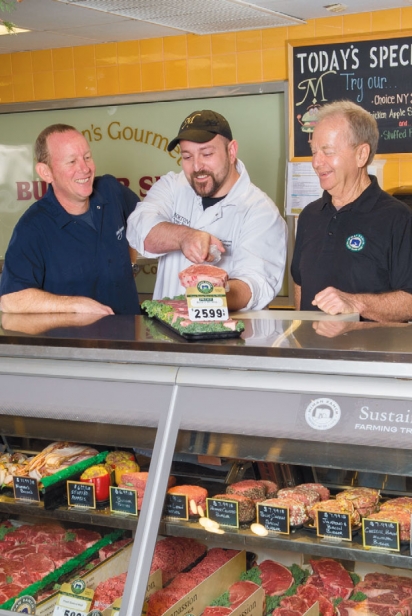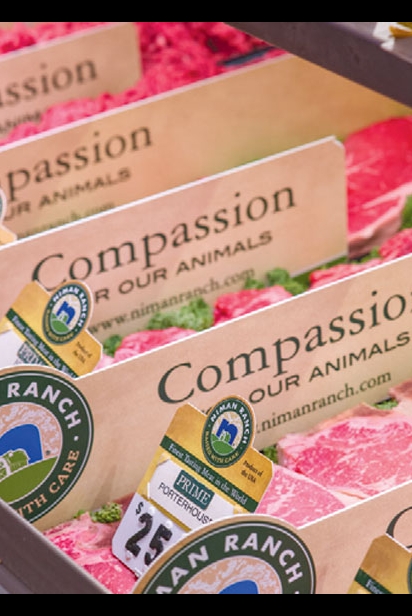Niman Ranch: The Farmer, the Butcher, and the Chef
Indigenous chef and restaurant owner Steve Phelps has visited many farms and seen a lot of food operations, but something about watching Paul Willis handle a baby hog in September felt different.
On most farms, someone trying to snatch a suckling pig away from its mother might piss her off something fierce. When Willis jumped a fence and grabbed a baby hog, though, the mother didn’t even bat an eyelash.
“The pig just looked at him,” Phelps remembers, “and it was OK.”
Phelps traveled to Iowa to attend Niman Ranch’s 16th annual Hog Farmer Appreciation Dinner, at which more than 650 family farmers and chefs were honored for their role in Niman’s humanely and sustainably raised pork operation. While the Niman name has become synonymous with highquality, ethical husbandry, it’s actually not one specific ranch but rather a network of hundreds of farms committed to following the company’s textbook-thick set of animal care rules.
In addition to the dinner, guests were invited to tour a Niman farm, and the experience was nothing less than transformational for Phelps. You would never think of a hog farm as clean, but that’s what Phelps saw. Niman hogs grow up mostly outdoors, soaking up sunshine and grazing on natural vegetation in addition to the feed and water they find in small huts set out around the farm. Nothing like an industrial hog farm, where the animals are confined indoors, where their tails are severed to prevent other hogs from biting them off , where immense liquid manure pits give off a deathly odor. At a Niman farm, Phelps says, the families treat their pigs like pets.
When he returned to Sarasota, Phelps took a hard look at his menu and his practices and immediately swapped pork and beef suppliers. The Iowa trip was more than just a visit to a farm, Phelps says: “It was life-changing.”
Old-School Methods
For centuries, before the advent of industrial farming, all pigs were raised using the methods Phelps saw in Iowa. Then, in the late 1980s and early ’90s, Willis and hog farmers like him started hearing about another philosophy: “Get bigger or get out.”
In the decades that followed, factory farming completely transformed the pork industry. According to statistics compiled by Food & Water Watch, a D.C. nonprofit that pushes for policies that support healthy and safe food and drinking water, in 1992 fewer than one third of American hogs were raised on farms with more than 2,000 animals. By 2007, 95 percent of pigs were being brought up on farms with more than 2,000 hogs. The average number of animals on a single hog farm increased from 3,612 in 1997 to 5,144 a decade later.
The result? Abusive practices, massive manure spills and the widespread use of antibiotics to combat new diseases spread through the factory system.
“I had no desire to go in that direction,” Willis says. “It wasn’t humane to raise animals like that.”
But while the concept of free-range chickens had already spread by then, not so much for freerange pigs. There was no real market for the kind of pork Willis was producing.
Then he met Bill Niman.
Niman founded Niman Ranch as an 11-acre cattle ranch in the early ’70s, eventually establishing the company as an industry leader in humanely raised beef. A friend hooked Willis up with Niman, who simply instructed, “Send me some pork.” Niman loved what Willis shipped to him, and in February 1995 Willis sent 30 pigs to Niman. And guess what: They sold well.
One hallmark of Niman products is the ability for the end recipient to trace the origin of his or her meat back to the family farm that produced it. For Willis, the experience of knowing how his pigs were slaughtered and how and where they were distributed was a marked change from the system he knew, in which he would simply sell his pigs to the highest bidder.
“I’d just take a load of hogs to Cargill or Hormel and that was the last I ever saw of it,” Willis says. “It went to the great grocery store in the sky.”
Willis knew Iowa neighbors who were also raising their pigs the right way, so he started reaching out to them to connect them with Niman. But it was important to create a universal set of standards for how the hogs would be treated, rules based on a pig’s natural habits. The goal is to “allow the animals to be what they are,” Willis says. But even Willis’ farm wasn’t at first living up to that standard. “We used to clip tails just because everybody did,” he says. That practice, along with using feed loaded with antibiotics, ended quickly.
The Niman pork network has now grown to encompass more than 500 farms. While that sounds enormous, Willis puts the company’s output in perspective. There are more than 8,000 confinement operations in Iowa alone, with a daily kill of 400,000 hogs. Niman produces 3,000 each week.
“It’s still a very special thing,” Willis says.
Find It Locally
You can see evidence of that in Southwest Florida. Morton’s Gourmet Market has carried a solid selection of Niman beef for seven years, but no other local store stocks Niman products. Morton’s Head Butcher Adam Lawrence says knowing where his meat comes from is vital.
“I want to know where it comes from. I want to know who touches it.” Niman’s transparency enables Lawrence to do just that.
That’s also what convinced Phelps he needed to start buying from Niman. He had been ordering pork belly from a local purveyor, but when pressed for details on how the pigs were treated, the company couldn’t satisfy Phelps. It’s a dilemma that conscientious chefs around the world are facing more and more frequently: What’s most important? The ethical treatment of animals? Or limiting the amount of carbon burned up getting your pork to your restaurant? Purchasing the highest-quality product? Or supporting farmers in your area?
Transformed by his trip to Iowa, Phelps sided with Niman, and has begun buying the pork belly, bacon, lamb and ground beef on his menu from the company. Niman products cost more, but Phelps has avoided gouging his diners by presenting less-celebrated cuts.
That’s another hallmark of Niman products—using the whole animal, which fits in squarely with Willis’ philosophy of raising pigs the same way they did 100 years ago. Willis has given up hog farming himself, but when he was in the business, it was never about the meat. It was about the animal.
“I wasn’t raising pork chops,” Willis says. “I was raising pigs.”







